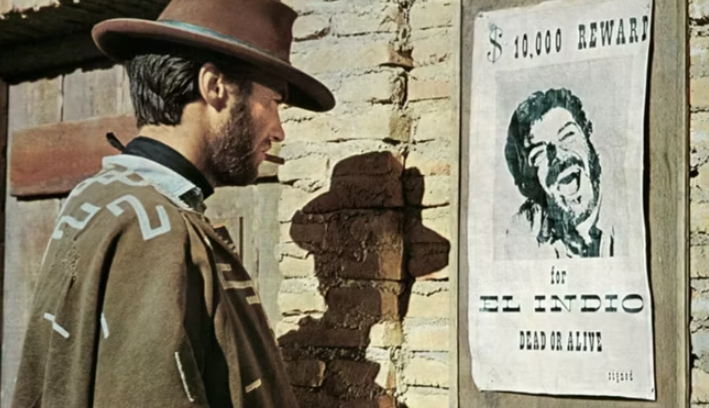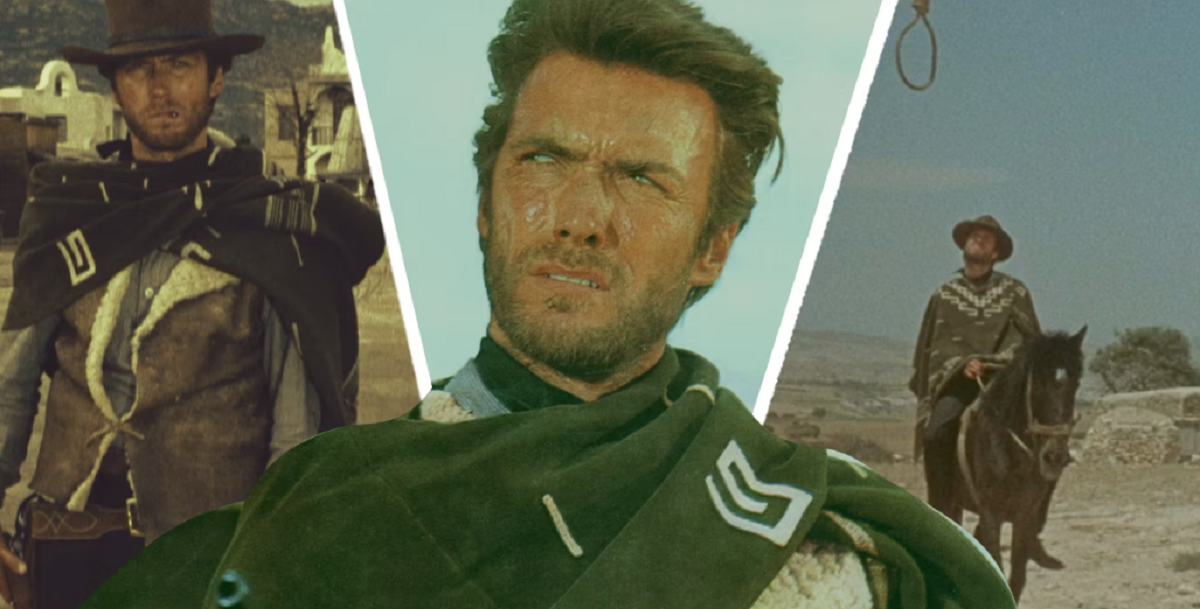Sergio Leone’s Dollars Trilogy catapulted Clint Eastwood to international stardom and revolutionized the Western genre.
While Clint Eastwood achieved success on the Western television seriesRawhide, which aired on CBS for eight seasons between 1959 and 1965, he gained international film stardom in Europe as the Man with No Name in Sergio Leone’s Dollars Trilogy Spaghetti Western film series. Leone never intended for the first installment, A Fistful of Dollars, to be the beginning of a trilogy. The film’s American distributor, United Artists, saw commercial potential in releasing A Fistful of Dollars and the next two installments, For a Few Dollars More and The Good, the Bad and the Ugly, as a trilogy and invented the Man with No Name concept for this purpose.
While Eastwood’s Man with No Name has different nicknames and motivations in each of the three films, the consistent appearance and tone that Eastwood maintains throughout the series gives the series the feel and look of being a spiritual trilogy, which could have been magnified if Eastwood had starred in Leone’s 1968 Spaghetti Western film Once Upon a Time in the West. Regardless, Leone showed amazing foresight in organizing the three films in ascending order of achievement and excitement, culminating in Eastwood and Leone’s grand masterpiece.
Sergio Leone Defined Clint Eastwood’s Screen Persona

Beginning with A Fistful of Dollars, Sergio Leone enabled Clint Eastwood to transcend television stardom by providing Eastwood with a screen persona, the Man with No Name, which revolves around Eastwood’s incomparable ability to communicate volumes through a bare minimum of dialogue. A Fistful of Dollars, which is an unofficial remake of the 1961 Akira Kurosawa samurai film Yojimbo, opens with the Man with No Name arriving in the Mexican-United States border town of San Miguel, where he becomes entangled in a feud between two rival smuggling families while eying a shipment of gold that passes through the town.
As an introductory film, A Fistful of Dollars, which was made for approximately $200,000, is highlighted by Eastwood’s charismatic, distinctive presence and Leone’s meticulous, stylish direction, which combines with Ennio Morricone’s haunting, whistling musical score to achieve an operatic effect. Moreover, Eastwood and Leone created a new kind of Western film with A Fistful of Dollars by presenting the Man with No Name as an ambiguous anti-hero who can, like James Bond, dispense violence with relentless fury and seemingly emerge from any dangerous situation unscathed, as if he’s a ghost.
For a Few Dollars More Raised the Stakes
In the second installment in the Dollars Trilogy, For a Few Dollars More, Clint Eastwood is paired with veteran character actor Lee Van Cleef, who plays Colonel Douglas Mortimer, a former Confederate Army Colonel turned bounty hunter who joins forces with Eastwood’s Man with No Name, nicknamed Manco, to find El Indio, a sadistic Mexican bandit whom Mortimer has a personal connection.
In one of the most intense scenes that Sergio Leone ever directed, Indio, having been freed from prison by his gang, visits the bounty hunter who was responsible for Indio’s imprisonment and challenges the man to a duel after killing the man’s child and wife. Indio unveils a musical pocket watch, which he plays when engaged in a duel. When the music stops, the shooting begins.
For a Few Dollars More transcends its fairly standard revenge plot through strong chemistry between Eastwood and the scene-stealing Van Cleef, the presence of a magnificently despicable villain, and Leone’s skillful use of extreme close-up shots. Moreover, For a Few Dollars More represents a clear progression from A Fistful of Dollars in terms of complexity and scale and heralds a spectacular conclusion to the Dollars Trilogy.
The Good, The Bad and the Ugly is Eastwood’s Western Magnum Opus

The third and final film in the Dollar Trilogy, The Good, the Bad and the Ugly is set during the American Civil War. It opens with Clint Eastwood’s Man with No Name (referred to as Blondie in the film) and Mexican bandit Tuco, played by Eli Wallach, running a con game in which Blondie collects bounties on Tuco, who is then rescued by Blondie before being hanged.
While the relationship between Blondie and Tuco might have sustained a film of the relatively modest ambition and scale of A Fistful of Dollars, Sergio Leone populates the nearly three-hour-long The Good, the Bad and the Ugly with various other concepts and sequences. Blondie and Tuco are joined in the film by Lee Van Cleef’s Angel Eyes, a mercenary who is in pursuit of a cache of Confederate gold, which is buried in a grave in an expansive cemetery in Spain. Blondie knows the name of the grave, while Tuco knows the name of the cemetery. This sets the stage for the first Mexican standoff scene in the history of cinema.
The Good, the Bad and the Ugly explores the Civil War, both in terms of its horrors and spectacle and for establishing the film’s underlying themes of compassion and empathy. When Blondie and Tuco encounter a dying Confederate soldier, Blondie comforts the shivering young man by covering the young man with Blonde’s trademark jacket and then offering the soldier a puff of Blondie’s cigar.
One of the greatest and most influential films in history, The Good, the Bad and the Ugly is fueled by Ennio Morricone’s genre-defining musical score. It established Eastwood’s Man with No Name as a perfectly realized screen hero and Leone as a filmmaker of limitless ambition and vision. At the same time, Leone created his own mythic identity, all while inventing the Spaghetti Western genre.
